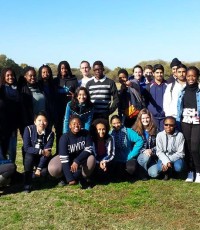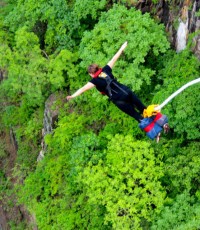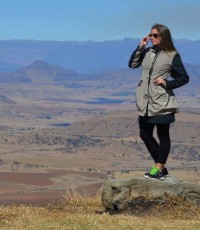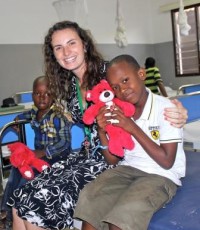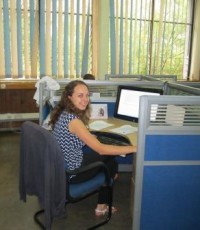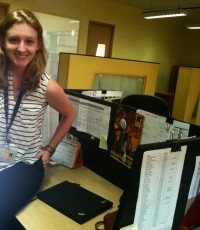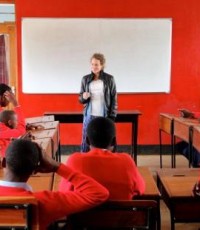July - August 2015
Dear Friends,
We hope you enjoy this last Fellows Flyer edition from our 2014-15 Fellows! As it turns out, it’s my last edition of the Fellows Flyer too. I’ll be stepping down as PiAf’s Executive Director in September. Over the past 3.5 years, I’ve been inspired daily by our Fellows and the organizations they serve, enjoyed spending time with my incredible PiAf team, learned a lot, and worked hard to strengthen our fellowship program and PiAf operations.
But a new Executive Director, Jodianna Ringel, will join Princeton in Africa in mid-September, and will do a fantastic job leading PiAf in the future. Jodianna brings a passion for Africa, from her time traveling in West Africa sourcing products for a fair trade business she co-founded, an understanding of how impactful our fellowship program can be, thanks to her own time as a Peace Corps volunteer, and significant nonprofit experience.
Of course, we also have an inspiring new 2015-16 fellowship class to introduce to you – this year, 51 Fellows will be working in 15 African countries supporting 31 organizations. You can read all about our new Fellows here and the organizations they are working with here.
Thank you for all the support I’ve received from the PiAf community. I hope you enjoy getting to know Jodianna and our new 2015-16 Fellows in the coming year.
Warm regards from Princeton,
Katie Henneman
Executive Director
P.S. Our 2016-17 fellowship application will go live by Monday, August 31, 2015, and applications will be due by Sunday, November 1, 2015 at 11:59PM EST. Please check out our website for more information or email piafapp@princetoninafrica.org to be added to our applicant mailing list.
PiAf Connections
Please click below to check out pictures of our Fellows, Alums and other members of the PiAf family meeting up at home and around Africa.
Notes from the Field
By Nada Ali, 2014-15 Fellow with Maru-a-Pula in Botswana
When I chose to accept a position teaching math in Botswana, I had expectations. Even before researching the landscapes, peoples, and cultures of this sparsely populated Southern African country, I had already developed a notion of what my yearlong experience would entail. Regarding my job, I thought: I have been a student, so how hard could it be to wear the teacher’s hat?
The danger of this mindset lies in the assumption I had made, that the relationship between the instructor and the instructed is by necessity top-down in nature. I would stand in front of my 30 students, book and whiteboard marker in hand, and do what I was supposed to do. That is, deliver knowledge that I possessed to those who did not. All the while in my mind was this doubt that what I was doing exhibited no aspect of what service is, what Princeton in Africa is all about.
Eventually, it became clear that my cut-and-dry technique would not work with my 14-year-old students, and so I revised my methods. Inside the classroom, instead of doing all the talking, I incorporated group activities, individual investigations, and frequent assessments to measure progress. Outside class, I made efforts to get to know my students in between class and during co-curricular activities. As a result, they opened up, performed better on exams, and were decidedly less zombie-like during class.
Assumptions and expectations about an unknown place or its peoples bear little consequence until they inform actions, which in turn leave lasting impacts on our communities. I assumed that my role at Maru-a-Pula could be carried out in a singular fashion and expected it to be easy. As a teacher, my students bore the burden of my actions. Even though I did not anticipate some of the challenges I would face in my role, what saved me was a willingness to stop, reassess, and adapt.
It is only now as I sit at home and reflect on my short career as a math teacher that I finally grasp the connection between service and teaching. The world of development may appear to be little more than programs provided by benefactors to beneficiaries. But even this rhetoric, rhetoric that is all too familiar to many of us, implies a top-down approach to service. It lacks personalization and undermines the beneficiary’s agency, just as my initial teaching approach had done in the classroom. Perhaps that is the greatest lesson I have learned from my time in Botswana: that I am not supposed to give or impart anything to my community, but rather to contribute to it. To me, this idea is at the core of all of Princeton in Africa’s fellowship posts.
Notes from the Field
By Margaret Derby, 2014-15 Fellow with African Impact in Zambia
This past year as a Project Coordinator at African Impact has been an amazing journey, and I felt one of the best ways to share it was through the completion of a few of my bucket list items:
#10 – Bungee Jump
As I’ve said to all who have asked, “It was amazing, and I’ll never do it again.” There’s something about bouncing upside down that I’m not a fan of, and even though I knew logically that if my shoes fell off I wouldn’t fall to my death, when my shoes started to feel like they were slipping, panic ensued. That being said – the Batoka Gorge has become one of my favorite places in the country, and leaping face first into it was the experience of a lifetime.
#52 – Learn to Drive Stick Shift
“Mzungu bus-ey!” is one of the phrases I hear most in my job with African Impact. It refers to our two 12-seater vans that carry volunteers to and from their community projects. African Impact works closely with five “suburbs” of Livingstone, commonly called compounds, which range from 10 – 30 minutes outside of town center. In the compounds, volunteers work with our community partners on a variety of projects, such as adult literacy courses, HIV education, assisting with community farms, and more. When our drivers are out of the office, international staff take the Mzungu Bus for a spin, which meant learning stick shift was one of my first tasks on the job. It’s a skill I’m grateful for, though I’m not sure how well it will translate back home after a year of driving on the left side of the road.
#48 – See Victoria Falls
It was on my bucket list far before I knew I’d live next door to it, and for good reason. It never fails to take my breath away, and having the ability to see it as often as I’ve wanted this year has been incredible.
#68 – Own an Original Work of Art
Livingstone is a major tourist town, and, as such, a lot of the culture has either become over-dramatized or disappeared in favor of Western restaurants and tourist activities. But, when a new art gallery opened up in October, people showcased their culture, thoughts, politics, and more through powerful artwork. I fell in love with a piece done by a local man on the importance of women’s rights in Zambia. It says a lot about the frustrating dynamic of gender roles in Zambia and fits with my work helping African Impact launch its first-ever gender empowerment program. Getting it home might be a struggle, but it’s been the best purchase I’ve made here.
#2 – Visit Every Country in the World
I’m definitely not crossing this off my list completely, but adding Zambia (and six others) to the list of countries I’ve made it to is the most significant item on this list. As my fellowship comes to an end, I am endlessly thankful for the lessons Zambia has taught me, the people it has shared with me and the memories it has given me. Zambia will have a piece of my heart forever.
Notes from the Field
By Kaitlin Hodge, 2014-15 Fellow with UN World Food Programme in Malawi
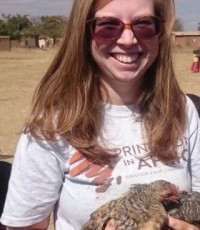
Kaitlin helping out on “Farm Day” by vaccinating local chickens to prevent Newcastle Disease, a highly contagious disease that can devastate poultry populations.
As the pickup truck rounds the corner, I see the bridge has caved in so that we’ll have to go down and around it. It doesn’t take much effort to navigate the little stream, since it’s well into the dry season, but when the rains start again it will become impassable, cutting off the village on the other side. Our logistics team back at the World Food Programme (WFP) is constantly assessing situations like this to prevent disruptions to our food assistance programmes, but this time I’m not here in my WFP hat. My travel companions work for the Lilongwe Society for the Protection and Care of Animals (LSPCA), an animal welfare clinic where I spend my Saturdays, and today is Farm Day.
As we pull up to the dusty field, a group of soccer-playing children is quick to approach. One of the nurses instructs the kids to collect their animals, promising free veterinary care and vaccinations. A loudspeaker announces the same to the adults. It’s calm for a time as the children trickle off, and I notice the field is bordered by a luscious garden growing along a small ravine – a welcoming reminder of the greens that blanketed the country during the all-too-brief rainy season. Over 80 percent of Malawians are smallholder farmers who depend on rain for their food, making the increasingly frequent and severe climate shocks of recent years all the more devastating.
My reverie is interrupted by a literal stampede. Cows, goats, dogs, ducks, donkeys, so so so many chickens. And Rihanna, booming in the distance.
I learn many things at Farm Day. How to vaccinate a chicken (through the eyes, if you’re wondering) and how to hold a bunny rabbit with dignity (not by the ears) without getting scratched. That stray dogs should be kept in separate corners of the vaccination lines, unless breaking up a fight club is on your bucket list. That a pig’s squeal ought to form the soundtrack of thriller films, and how to pin a goat’s horns while vaccinating it to prevent said horror-movie-inspired goring.
Most of all, I see through my own eyes what the reports on my desk back at WFP have been telling me all year. Animals are not just (wo)man’s best friend here, but also hold tremendous significance for lives and livelihoods. Dogs make great guards, but an unvaccinated one can mean the death of an unsuspecting child. Chickens, goats and pigs ensure a source of income even when the crops fail, and donkeys, for those who can afford them, can be a tremendous boost to agricultural productivity – so it’s in a family’s interest to ensure they are cared for properly.
As we drive back to Lilongwe I think of my own cat I adopted here who, though he did not live long, provided many common laughs between me, my housekeeper and my guards, and I realize: for all their usefulness, their goofy, lovable antics still make pets the best universal translator.
Notes from the Field
By Rachel Jones, 2014-15 Fellow with Clinton Health Access Initiative in South Africa
My experience costing South Africa’s Central Chronic Medicines Dispensing and Distribution (CCMDD) program over the past year as a Fellow with the Clinton Health Access Initiative has been a lesson in identifying gaps in policies and governance. I’ve realized, for example, that governments must often assemble budgets without critical information regarding the viability of their investments. As I maneuvered among the National Department of Health, district health services, and healthcare personnel, I observed environments where information and communication bottlenecks hampered potentially transformative policies. Ideally policies should originate in knowledge of the local contexts they seek to influence and in direct consideration of how they will be implemented, while remaining amenable to lessons learned from implementation. In practice, successful policies rely on proactive communication between national and regional levels of government. I see an opportunity to create impact fostering this type of exchange, and now, at the end of my fellowship year, this is the type of opportunity I’m looking to take forward.
An important aspect of my work on CCMDD was the recommendation that the National Department of Health reconsider the program’s reliance on the direct delivery of medicines from manufacturers to health care facilities, since direct delivery is costly and associated with a high rate of delivery errors. I met with directors from the Western Cape Department of Health who had improved depot management holistically by integrating procurement and finance functions under one roof, thereby minimizing the occurrence of nation-wide medicine stock-outs. I believe that provincial governments could learn from the experiences of Western Cape.
My work with CHAI has opened my eyes to the vast opportunities available to governments to improve policies and their implementation by engaging regional governments and stakeholders in a feedback loop. Facilitating such processes, I have used my abilities to analyze systems critically, synthesize different streams of information, and ascribe priority among competing voices. I have had to earn the trust of local governments and those on the ground so that they would speak candidly about the obstacles they face as implementers. I have also been challenged to frame local experiences and recommendations in a way that increases their traction among policy-makers.
This fall I’ll begin my Masters in International Development Policy, a program that I hope will position me to advocate for the strategic union of development policy and practice. I’d like to come out equipped to engage policy-makers as stakeholders in the work that begins where policies end. Thanks to my work with CHAI, I know that this is a space with ample room for me.
Notes from the Field
By Erin Keating, 2014-15 Fellow with Comprehensive Community Based Rehabilitation in Tanzania in Tanzania
Anyone who knows me knows that I absolutely, utterly adore children. I am obsessed with them – from their chubby cheeks to their tiny toes. Working at Comprehensive Community Based Rehabilitation in Tanzania (CCBRT) in Dar es Salaam has afforded me the opportunity to interact with children of all ages, which is something that brings me great joy and personal fulfillment on a daily basis. As CCBRT’s Communications Officer, I regularly visit our Disability Hospital, interviewing children and their parents for case studies, taking photos for our social media platforms, and, of course, trying to make our youngest patients giggle by any means possible.
With one of my best friends due to have a baby just days before the end of my fellowship, children have been on my mind even more than usual lately. While most of my thoughts are consumed with meeting this bundle of joy and watching her grow into a happy, well-adjusted child, part of me is filled with anxiety when I think about her arrival. Will she be born healthy? Will all the wishes and dreams that her family and friends have for her be able to come true? Or will some type of injury, illness or disability hold her back from reaching her full potential? Fortunately for my friend’s daughter, she will be born at a hospital in the United States and will be cared for by highly-trained and qualified doctors and nurses. If she is born with any medical conditions, clinicians will diagnose them immediately and provide her with the appropriate treatment.
Many children in Tanzania are not so lucky.
The following are some of the most common congenital conditions seen at CCBRT, the treatments for which are readily available to most children in the US, but remain difficult for thousands of children in Tanzania to access.
Congenital cataracts – A clouding of the lens of the eye. Without treatment, a child with this condition can experience irreversible vision loss. Congenital cataracts can be corrected with a short surgery.
Clubfoot – A bone deformity where the foot is twisted inward and the sole of the foot cannot be placed on the ground. A person living with clubfoot might be forced to walk on the sides of his feet or toes, or may not be able to walk at all. Surgery or a series of inexpensive castings can effectively treat this condition.
Cleft lip/palate – A defect where either a baby’s lip (cleft lip) or palate (cleft palate) is not fully formed at birth. Cleft lip and/or palate can cause a child to have difficulty speaking or eating, dental problems, or frequent ear infections. Cleft lip and cleft palate can be fixed through a single surgical procedure.
Every day, the CCBRT team works tirelessly to ensure that all children in Tanzania have access to high quality and affordable care for these conditions. I am truly grateful to PiAf for allowing me to have the opportunity to contribute to this effort during my fellowship year.
Notes from the Field
By Lorna Morris, 2014-15 Fellow with UN World Food Programme in Rwanda
Looking back on my fellowship, I feel incredibly lucky to have spent a year working for WFP Rwanda. As a Reports Officer in the Programme unit, I have been able to learn about and visit a range of WFP’s projects, to develop skills in donor and performance reporting, and to develop a much deeper and more nuanced understanding of areas such as food security, nutrition, project management, and the role of donor funding in international development.
Here are a few lessons (amongst many) that I am taking away from my year as a Fellow:
+ Being the first Fellow at my placement had its challenges and was at times difficult, but this aspect of my fellowship experience also created opportunities for which I am thankful.
+ Understanding and adapting to new gender dynamics both outside and inside the office was more challenging and frustrating than I had anticipated, but was also a source of personal growth in the last year and has made me think about what field I hope to work in, in the future.
+ Funding is an ever-present driving force and limiting factor in international development. Planning ahead is difficult when long-term funding beyond the next three months cannot be guaranteed, and this heavily influences the way projects are designed and implemented.
+ Rwanda really is ridiculously beautiful. Long drives outside Kigali for work or weekend trips simply never get old thanks to jaw-dropping views of the “Land of a Thousand Hills.”
+ Focusing on efficiency and getting information or help from others as fast as possible to meet a deadline only gets you so far. To really get things done, you need to slow down and actually invest in your conversations and interactions with people.
+ Fried grasshoppers are delicious, and make an excellent snack on long bus rides.
+ Taking on tasks outside my official job description led to some of the most memorable and challenging experiences I had at work, such as helping to organize and participating in a disaster simulation exercise for a refugee influx.
+ The most unexpected aspects of my fellowship year were also some of the most rewarding. While visiting reception centres on the Rwanda-Burundi border and watching the establishment of a new refugee camp have been sobering experiences, seeing and supporting WFP’s response to the influx of 70,000 Burundian refugees since April has been an incredible learning curve.
+ Sitting on a bus to Bujumbura for six hours while listening to Phil Collins songs on repeat can be surprisingly fun (credit due in large part to Oluseyi Segun, 2014-15 Fellow with Gardens for Health International!)
+ The WFP canteen is one of the places where I consistently learned the most during my fellowship year. Lunch hour conversations allowed me to build relationships with people I didn’t work with directly and to learn far more about my colleagues and about Rwanda than I could have done otherwise.
Notes from the Field
By Elizabeth Quinlan, 2014-15 Fellow with International Rescue Committee in Kenya
What’s in a Cubicle?
My cubicle in the International Rescue Committee (IRC)’s Kenya program office speaks volumes about the day-to-day nuances that have made this a complex and vibrant fellowship year. When I began my fellowship year, I had a very different vision of humanitarian service from the reality that played out over the next few months. My post has me boxed in by three one-inch plywood walls and sitting in front of a 12-inch Lenovo laptop screen squinting against the fluorescent lighting at Excel sheets and grant reports. Over this year, though, I’ve come to see my role as bigger than the office box to which I am limited: reporting and numbers-crunching are critical to strong program management, effective implementation by field teams, and productive relationships between the IRC and her donors. And so, allow me to take you on a tour of the small space that has pushed me to think outside the box and revisit my definition of ‘service.’
Visuals: At times I feel far-removed from the IRC’s beneficiaries, so I’ve made it a point to surround my cubicle with pictures of those we serve. There’s a report on The Cost of War in the South Sudan conflict, IRC Annual Reviews from 2011 and 2013, reports on our HIV/AIDS and malnutrition projects, and an information packet on the IRC’s Peace Initiative Kenya (PIK) project.
Drawers: Though my drawers hold the standard office supplies, my top five most prized drawer items are: black tea (a self-proclaimed addict), calculators (for calculating refugee numbers and program progress), scrap paper, eyeglasses (screen-squinting is hard on the contacts), and trail mix (I’m a snacker).
Calendars: I use a desktop calendar to plan for longer-term projects, like monitoring important grant dates over the course of a year or tracking our check-in calls with the IRC headquarters in New York and London. In front of me there’s a two-month timeline of upcoming grant reports that details the type of report and the managers and reviewers writing the report. I work on about 20 grants that fund the IRC’s projects in Kakuma and Turkana, so this is the calendar that keeps me sane on a daily basis.
Tools of the trade: Close at hand are my Lenovo laptop (a standard-issue item for any NGO worker), my planner notebook and pen, and my very beat-up yet reliable Nokia cell phone. The phone is key for communicating with the field-based staff and program managers. Often, the field does not have reliable internet, and the program managers who fill out reports also work full days in our clinics and communities. Working with them over the phone proves more effective than me sitting around waiting for a response to an email.
Ten months ago I never thought I would say this, but I’m going to miss my IRC Kenya cubicle. It’s been the stage for my challenges and successes of this year. It is by no means glamorous and certainly not the setting that first comes to mind when someone says ‘humanitarian aid work,’ but it’s pushed me to think about the type and value of work that I can provide in the service of humanitarianism.
Notes from the Field
By Morgan Wolf, 2014-15 Fellow with Indigenous Education Foundation of Tanzania in Tanzania
Personal space is something I’ve grown up believing is a given. I believe this is true for a lot of people. We navigate our days as individuals, connected and disconnected when we so choose to be. Living in a rural part of Tanzania, specifically working with IEFT at Orkeeswa Secondary School, however, has redefined this relationship. Personal space is regarded differently here. Some examples: the dala-dalas – the taxi-van public transportation – made for 16 people are usually filled with 25. Children grab at me as I run home from school, or will match my stride and walk closer behind me than my shadow. My conversations are consistently punctuated by responding to greetings (aggressively) shouted to me, that increase in urgency and volume and force if not at first responded to.
It leaves me feeling raw: vulnerable and exposed. And sometimes it leaves me feeling absolutely exhausted. And then, once exposed and exhausted, sometimes it leaves me feeling indignant and irate. I’m connected, my presence noticed, whether I choose to be or not.
But from this seeming invasion, something beautiful emerges. It’s an intuition like I’ve never experienced before.
I was on the dala-dala, especially incapable of movement, like T-rex arms style, struggling to zip and unzip my backpack. The woman sitting next to me noticed my struggle and began zipping and unzipping my bag as I needed, nodding to acknowledge my thanks.
In December, on the eve of one of my closest friends leaving for home for good, I was walking to school feeling sorry for myself and angry and terrified at the prospect of another goodbye, and was joined by several students who were also on their way to school. Without a word, one of the girls slipped her hand into mine and we walked like that for the last mile.
I get more hugs here than I have anywhere else. As they drive past me when I’m walking, the boda (motorcycle) drivers seem to sense when I am particularly tired or particularly frazzled, as these are the days I’m offered a lift into town zawadi, as a gift. Amidst what seemed like crisis after crisis, one of my fellow teachers asked – without this knowledge – with utmost sincerity, how is your family doing, how is your home.
I grew up drawing boundaries that delineated my personal space, that made me distinct and separate from my environment. And upon arrival here, those once-so-defined boundaries became blurred, as if I was no longer existing in an environment comfortably detached, but was rather a part of the environment. I became just as much a part of my surroundings as the rainstorm, the muddy patch of road I struggle daily to traverse, the way the sun slants at 7am in the morning, the older woman I say Shikamoo to and the school children in their blue sweaters and striped socks that say Shikamoo to me. Is it for the better or for the worse? Most days I’d say the former… I guess some days the latter… but I don’t know and honestly don’t think it’s to be judged one way or the other. What I do know is that living here I feel like I couldn’t be further from drifting or alone or isolated. I know I am a presence acknowledged, felt, responded to. And I know it’s made an awareness that I hope – that I want – to hold on to.






